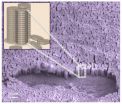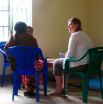(Press-News.org) Older adults often are readmitted after hospitalization for heart failure, pneumonia, and acute myocardial infarction, a significant issue that has caused Medicare to target hospitals with high 30-day readmission rates for financial penalties. Older adults are also often admitted for reasons other than the original hospitalization. This vulnerability to readmission has been referred to as "post-hospital syndrome." However, whether younger patients also experience a similar pattern of readmission has not been well studied.
In a large cohort study, Isuru Ranasinghe and colleagues (Yale-New Haven Hospital, New Haven, CT, USA) used California's Healthcare Cost and Utilization Project inpatient dataset, which included 206,141 hospitalizations for heart failure, 107,256 for myocardial infarction, and 199,620 for pneumonia from 2007 to 2009. They found that patients aged 18-64 years had higher readmission rates for heart failure than patients aged ≥65 years (23.4% vs. 22.0%), and lower readmission rates for myocardial infarction (11.2% vs. 17.5%) and pneumonia (14.4% vs. 17.3%). After they adjusted for the confounding factors of sex, race, comorbidities, and payer status, they found that readmission rates between the groups were very similar (for heart failure readmission in younger compared with older adults, hazard ratio [HR] 0.99; 95%CI 0.97-1.02; for pneumonia, HR 0.97; 95%CI 0.94-1.01; and for myocardial infarction, HR 0.92; 95%CI 0.87-0.96). For older and younger patients, the timing of readmission was similar; readmission risks were highest between days 2-5 post-discharge. Similar to older patients, younger patients often were readmitted for reasons other than the original hospitalization: among those with heart failure, 39-44% of readmissions were not heart-related; for myocardial infarction, 37-45% were not heart-related, and for pneumonia, 61-64% were not pulmonary related.
In addressing this similarity in readmission patterns, the authors note, "patients aged 18+ years, like those aged ≥65 years, may also experience a post-hospital syndrome," a transient period of generalized vulnerability. The authors further note, "...recent policy changes such as the Hospital Readmissions Reduction Program have incentivized interventions to reduce readmissions by enforcing financial penalties on hospitals with high readmission rates. Many of these targeted interventions are aimed at elderly patients. Our finding of a generalized risk of readmission, and broad yet predictable readmission diagnoses and timing, strongly suggests the need for development of more broad-based multi-disciplinary strategies to mitigate this risk." Younger patients were more likely to have comorbidities of drug and alcohol use and psychiatric disorders, although these were not the primary reasons for readmission. The authors conclude, "While readmission is often perceived as a problem among elderly patients, our data suggests that readmission should be considered"—in US policies that have emphasized readmissions of elderly patients only and by researchers and clinicians—"as a broader issue that extends to all hospitalized patients."
INFORMATION:
Research Article
Funding: This study was funded by grant 1U01HL105270-03 (Center for Cardiovascular Outcomes Research at Yale University) from the National Heart, Lung, and Blood Institute. IR is supported by an Early Career Fellowship co-funded by the National Health and Medical Research Council of Australia and the National Heart Foundation of Australia. KD is supported by grant T32HL007854 from the National Heart, Lung, and Blood Institute; he is also supported as a Centers of Excellence Scholar in Geriatric Medicine at Yale by the John A. Hartford Foundation and the American Federation for Aging Research. The content is solely the responsibility of the authors and does not necessarily represent the official views of the National Health and Medical Research Council of Australia, the National Heart Foundation of Australia, the American Federation for Aging Research, or the National Institutes of Health. The funders had no role in study design, data collection and analysis, decision to publish, or preparation of the manuscript.
Competing Interests: YW, SB, and HMK work under contract with the Centers for Medicare & Medicaid Services to develop and maintain performance measures. HMK is chair of a cardiac scientific advisory board for UnitedHealth and is the recipient of a research grant from Medtronic, Inc. through Yale University. HMK is a consultant to Premier, Inc. and VHA, Inc.
Citation: Ranasinghe I, Wang Y, Dharmarajan K, Hsieh AF, Bernheim SM, et al. (2014) Readmissions after Hospitalization for Heart Failure, Acute Myocardial Infarction, or Pneumonia among Young and Middle-Aged Adults: A Retrospective Observational Cohort Study. PLoS Med 11(9): e1001737. doi:10.1371/journal.pmed.1001737
Author Affiliations:
Center for Outcomes Research and Evaluation, Yale-New Haven Hospital, UNITED STATES
Columbia University Medical Center, UNITED STATES
School of Medicine, Yale University, UNITED STATES
School of Public Health, Yale University, UNITED STATES
Contact:
Isuru Ranasinghe
Center for Outcomes Research and Evaluation
Yale-New Haven Hospital
UNITED STATES
+1 (203) 200-5336
isuru.ranasinghe@yale.edu
Rehospitalization in younger patients
2014-09-30
ELSE PRESS RELEASES FROM THIS DATE:
Diuretics in proton pump inhibitor-associated hypomagnesemia
2014-09-30
Proton pump inhibitor (PPI) therapy is associated with hospitalization for hypomagnesemia, particularly among patients also receiving diuretics, according to research published this week in PLOS Medicine. The study, conducted by David Juurlink of the University of Toronto and colleagues, suggests that physicians reconsider long-term PPI therapy for patients with a diagnosis of hypomagnesemia or concurrent use of diuretics.
Roughly 145 million prescriptions for PPI are dispensed in the United States annually for acid-related disorders such as dyspepsia and gastroesophageal ...
At dusk and dawn: Scientists pinpoint biological clock's synchronicity
2014-09-30
Scientists have uncovered how pacemaker neurons are synchronized at dusk and dawn in order to maintain the proper functioning of their biological clocks. Their findings, which appear in the journal PLOS Biology, enhance our understanding of how sleep-wake cycles are regulated and offer promise for addressing related afflictions.
"We've known for some time that the time-keeping of our biological clocks is a complex enterprise," says New York University's Justin Blau, a professor of biology and neural science and one of the study's co-authors. "But our results offer new ...
How dinosaur arms turned into bird wings
2014-09-30
Although we now appreciate that birds evolved from a branch of the dinosaur family tree, a crucial adaptation for flight has continued to puzzle evolutionary biologists. During the millions of years that elapsed, wrists went from straight to bent and hyperflexible, allowing birds to fold their wings neatly against their bodies when not flying.
How this happened has been the subject of much debate, with substantial disagreement between developmental biologists, who study how the wings of modern birds develop in the growing embryo, and palaeontologists who study the bones ...
Study shows how chimpanzees share skills
2014-09-30
Evidence of new behaviour being adopted and transmitted socially from one individual to another within a wild chimpanzee community is publishing on September 30 in the open access journal PLOS Biology. This is the first instance of social learning recorded in the wild.
Scientists from University of St Andrews, University of Neuchâtel, Anglia Ruskin University, and Université du Quebec studied the spread of two novel tool-use behaviours among the Sonso chimpanzee community living in Uganda's Budongo Forest. Dr Catherine Hobaiter, Lecturer in Psychology at the University ...
Boys and girls who've had a traumatic brain injury differ in rates of harmful behavior
2014-09-30
TORONTO, Sept. 30, 2014 – Teenagers who said they had a traumatic brain injury in their lifetime, especially girls, also reported significantly higher rates of harmful behavior, according to new research.
The study looked at 13 harmful health behaviours –such as contemplating suicide, smoking marijuana or binge drinking– among 9,288 Ontario students between Grades 7 and 12.
"Both boys and girls were more likely to engage in a variety of harmful behaviours if they reported a history of TBI, but girls engaged in all 13 harmful behaviours we looked for, whereas boys were ...
Blades of grass inspire advance in organic solar cells
2014-09-30
AMHERST, Mass. – Using a bio-mimicking analog of one of nature's most efficient light-harvesting structures, blades of grass, an international research team led by Alejandro Briseno of the University of Massachusetts Amherst has taken a major step in developing long-sought polymer architecture to boost power-conversion efficiency of light to electricity for use in electronic devices.
Briseno, with colleagues and graduate students at UMass Amherst and others at Stanford University and Dresden University of Technology, Germany, report in the current issue of Nano Letters ...
Comprehensive Study of allergic deaths in US finds medications are main culprit
2014-09-30
September 30, 2014—(BRONX, NY)—Medications are the leading cause of allergy-related sudden deaths in the U.S., according to an analysis of death certificates from 1999 to 2010, conducted by researchers at Montefiore Medical Center and Albert Einstein College of Medicine of Yeshiva University. The study, published online today in the Journal of Allergy and Clinical Immunology, also found that the risk of fatal drug-induced allergic reactions was particularly high among older people and African-Americans and that such deaths increased significantly in the U.S. in recent ...
The cultural side of science communication
2014-09-30
EVANSTON, Ill. --- Do we think of nature as something that we enjoy when we visit a national park and something we need to "preserve?" Or do we think of ourselves as a part of nature? A bird's nest is a part of nature, but what about a house?
The answers to these questions reflect different cultural orientations. They are also reflected in our actions, our speech and in cultural artifacts.
A new Northwestern University study, in partnership with the University of Washington, the American Indian Center of Chicago and the Menominee tribe of Wisconsin, focuses on science ...
Rating the planet's oceans
2014-09-30
The most comprehensive assessment conducted by the Ocean Health Index rates the Earth's oceans at 67 out of 100 in overall health. In addition, for the first time, the report assessed the Antarctic and the 15 ocean regions beyond national jurisdiction (high-seas areas) — all critical regions for maintaining a healthy climate, safeguarding biodiversity and providing sustainable food sources.
In the third annual update of the index, a partnership led by scientists from UC Santa Barbara's National Center for Ecological Analysis and Synthesis (NCEAS) and Conservation International ...
New diagnostic approach for autism in Tanzania
2014-09-30
PROVIDENCE, R.I. [Brown University] — Autism is no stranger to the children of Tanzania. What is rare in the East African nation is access to clinical services, including reliable diagnosis and evidence-based treatments. There is no autism diagnostic measure, for example, validated for use in Swahili, a major language of the region. In a small new study, however, researchers at Brown University and the University of Georgia (UGA) describe a culturally compatible diagnostic approach that they implemented at two sites in the country and found to be effective for making diagnoses.
The ...



